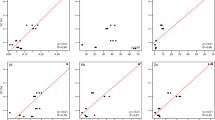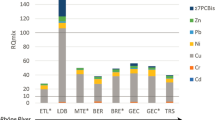Abstract
An ecotoxicological screening of environmental samples collected in the vicinity of rice fields followed a combination of physical and chemical measurements and chronic bioassays with two freshwater trophic levels (microalgae: Pseudokirchneriella subcapitata and Chlorella vulgaris; daphnids: Daphnia longispina and Daphnia magna). As so, water and sediment/soil elutriate samples were obtained from three sites: (1) in a canal reach crossing a protected wetland upstream, (2) in a canal reach surrounded by rice fields and (3) in a rice paddy. The sampling was performed before and during the rice culture. During the rice cropping, the whole system quality decreased comparatively to the situation before that period (e.g. nutrient overload, the presence of pesticides in elutriates from sites L2 and L3). This was reinforced by a significant inhibition of both microalgae growth, especially under elutriates. Contrary, the life-history traits of daphnids were significantly stimulated with increasing concentrations of water and elutriates, for both sampling periods.
Similar content being viewed by others
References
Albanis, T. A., Hela, D. G., Sakellarides, T., & Konstantinou, I. K. (1998). Monitoring of pesticide residues and their metabolites in surface and underground waters of Imathia (N. Greece) by means of solid-phase extraction disks and gas chromatography. Journal of Chromatography A, 823(1–2), 59–71.
Antunes, S. C., Pereira, R., & Gonçalves, F. (2003). Chronic responses of different clones of Daphnia longispina (field and ephippia) to different food levels. Acta Oecologica, 24, S325–S332.
Antunes, S. C., Pereira, R., & Gonçalves, F. (2007). Acute and chronic toxicity of effluent water from an abandoned uranium mine. Archives of Environmental Contamination and Toxicology, 53, 207–213.
A.P.H.A. (1995). Standard Methods for the Examination of Water and Wastewater (19th ed). Washington: American Public Health Association.
ASTM (American Society for Testing and Materials) (1980). Standard practice for conducting acute toxicity tests with fishes, macroinvertebrates and amphibians. Report E 729–80. Philadelphia, USA, American Society for Testing and Materials.
Azov, Y., & Goldman, J. C. (1982). Free ammonia inhibition of algal photosynthesis in intensive cultures. Applied Environmental Microbiology, 43(4), 735–739.
Baird, D. J., Barber, I., Bradley, M., Callow, P., & Soares, A. M. V. M. (1989a). The Daphnia bioassay: A critique. Hydrobiologia, 188/189, 403–406.
Baird, D. J., Soares, A. M. V. M., Girling, A., Barber, I., Bradley, M. C., & Calow, P. (1989b). The long-term maintenance of Daphnia magna Straus for use in ecotoxicity tests: problems and prospects. In H. Lokke, H. Tyle, & F. Bro-Rasmussen (Eds.), Proceedings of the First European Conference on Ecotoxicology (pp. 144–8). Denmark, Lyngby.
Buchanan, J. B., & Kain, J. M. (1971). Measurement of the physical and chemical environment. In: N. A. Holme, A. D. McIntyre (Eds.), Methods for the Study of Marine Benthos—IBP Handbook, no 16 (pp. 30–58). Blackwell Scientific Publications, UK.
Burns, C. W. (2000). Crowding-induced changes in growth, reproduction and morphology of Daphnia. Freshwater Biology, 43, 19–29.
Cedergreen, N., & Streibig, J. C. (2005). Can the choice of endpoint lead to contradictory results of mixture-toxicity experiments? Environmental Chemistry and Toxicology, 24(7), 1676–1683.
Cerejeira, M. J., Pereira, T., Silva-Fernandes, A., & Brito, F. (1999). Preliminary toxicity evaluation of water from rice fields using cost-effective microbiotests. Toxicology and Environmental Safety, 69, 373–380.
Chapman, P. M. (2000). Whole effluent toxicity testing—Usefulness, level of protection, and risk assessment. Environmental Chemistry and Toxicology, 19(1), 3–13.
Cheung, Y. H., Neller, A., Chu, K. H., Tam, N. F. Y., Wong, C. K., Wong, Y. S., et al. (1997). Assessment of sediment toxicity using different trophic organisms. Archives of Environmental Contamination and Toxicology, 32(3), 260–267.
Dodds, W. K., Jones, J. R., & Welch, E. B. (1998). Suggested classification of stream trophic state: Distributions of temperate stream types by chlorophyll, total nitrogen, and phosphorus. Water Research, 32(5), 1455–1462.
EC (European Commission) (2000). Council Directive 2000/60/EC of the European Parliament and of the Council of 23 October 2000 establishing a framework for community action in the field of water policy. OJ L 327, 22.12.2000.
EEC (European Economic Comission) (1992). Council Directive 92/43/EEC on the conservation of natural habitats and of wild fauna and flora. OJ L 206, 22.7.92.
Ervin, G. N., & Wetzel, R. G. (2003). An ecological perspective of allelochemical interference in land–water interface communities. Plant and Soil, 256(1), 13–28.
Finney, D. J. (1971). Probit analysis. Cambridge: Cambridge University Press (p. 333).
FOOTPRINT PPDB (The FOOTPRINT Pesticide Properties Database) (2010). FOOTPRINT: creating tools for pesticide risk assessment and management in Europe. Research Project in the 6th Framework Program for Research and Technological Development. http://sitem.herts.ac.uk/aeru/footprint/en/index.htm. Accessed July 2010.
ICN (Instituto para a Conservação da Natureza) (2008). Sistema de Informação do Património Natural. Áreas Classificadas: Rede Natura 2000. Instituto de Conservação da Natureza. Available at http://www.icn.pt/sipnat/. Accessed on March 2010.
Johnson, I., Hutchings, M., Benstead, R., Thain, J., & Whitehouse, P. (2004). Bioassay selection, experimental design and quality control/assurance for use in effluent assessment and control. Ecotoxicology, 13, 437–447.
Källqvist, T., & Svenson, A. (2003). Assessment of ammonia toxicity in tests with the microalga, Nephroselmis pyriformis, Chlorophyta. Water Research, 37(3), 477–484.
Konstantinou, I. K., Sakkas, V. A., & Albanis, T. A. (2001). Photocatalytic degradation of the herbicides propanil and molinate over aqueous TiO2 suspensions: Identification of intermediates and the reaction pathway. Applied Catalysis B: Environmental, 34, 227–239.
Koukal, B., Dominik, J., Vignati, D., Arpagaus, P., Santiago, S., Ouddane, B., et al. (2004). Assessment of water quality and toxicity of pollutant Rivers Fez and Sebou in the region of Fez (Morocco). Environmental Pollution, 131, 163–172.
Kukkonen, J., & Landrum, P. F. (1996). Distribution of organic carbon and organic xenobiotics among different particle-size fractions in sediments. Chemosphere, 32(6), 1063–1076.
Lampert, W. (1987). Feeding and nutrition in Daphnia. In: Dott. M. de Marchi (Ed.) Daphnia-Memorie dell’Istituto Italiano di Idrobiologia. USA: Consiglio Nazionale delle ricerche, Istituto Italiano di Idrobiologia—Verbania Pallanza.
Lapota, D., Duckworth, D., Word, J. (2000). Confounding factors in sediment toxicology. Issue paper: 1–19. San Diego, CA: Space and Naval Warfare Systems Center San Diego.
Law by Decree no. 384-B/99 of 23.09.1999. Permitiu adequar e compatibilizar os princípios, as medidas de conservação e os procedimentos relativos ao regime de protecção das zonas especiais de conservação (ZEC) e das zonas de protecção especial (ZPE), que irão integrar a Rede Natura 2000. DR n° 223, Série I, Parte A, de 23/09/1999, Suplemento 1.
Losso, C., Novelli, A. A., Picone, M., Marchetto, D., Pantani, C., Ghetti, P. F., et al. (2007). Potential role of sulfide and ammonia as confounding factors in elutriate toxicity bioassays with early life stages of sea urchins and bivalves. Ecotoxicology and Environmental Safety, 66, 252–257.
MA (Ministério do Ambiente) (1998). Law by Decree no. 236/98 de 1 de Agosto. Estabelece normas, critérios e objectivos de qualidade com a finalidade de proteger o meio aquático e melhorar a qualidade das águas em função dos seus principais usos. Ministério do Ambiente, do ordenamento do Território e do Desenvolvimento Regional, Diário da República—I Série-A, N° 176: 3676–3722.
Mayer, P., Frickmann, J., Christensen, E. R., & Nyholm, N. (1998). Influence of growth conditions on the results obtained in algal toxicity tests. Environmental Toxicology and Chemistry, 17(6), 1091–1098.
MED-Rice (2003). Guidance Document for Environmental Risk Assessments of Active Substances Use on Rice in the EU For Annex I Inclusion. Document prepared by Working Group on MED-RICE, EU Document Reference SANCO/1090/2000—rev.1, Brussels, June 2003, 108 p.
Mendonça, E., Picado, A., Silva, L., & Anselmo, A. M. (2007). Ecotoxicological evaluation of cork-boiling wastewaters. Ecotoxicology and Environmental Safety, 66, 384–390.
Meyer, J. S., Ingersoll, C. G., McDonald, L. L., Boyce, M. S. (1986). Estimating uncertainty in population growth rates: Jackknife vs. Bootstrap techniques. Ecology, 67, 1156–1166.
Moreira-Santos, M., Soares, A. M. V. M., & Ribeiro, R. (2004). An in situ bioassay for freshwater environments with the microalga Pseudokirchneriella subcapitata. Ecotoxicology and Environmental Safety, 59, 164–173.
Mucha, A. P., Leal, M. F. C., Bordillo, A. A., & Vasconcelos, M. T. S. D. (2003). Comparison of the response of three microalgae species exposed to elutriates of estuarine sediments based on growth and chemical speciation. Environmental Toxicology and Chemistry, 22(3), 576–585.
Nyholm, N., & Källqvist, T. (1989). Methods for growth inhibition toxicity tests with freshwater algae. Environmental Toxicology and Chemistry, 8, 689–703.
OECD (Organization for the Economic Cooperation and Development) (1998). Daphnia magna reproduction test–test guideline 211. Paris, France.
OECD (Organization for the Economic Cooperation and Development) (2002). Freshwater alga and cyanobacteria, growth inhibition test–test guideline 201. Paris, France.
Padovani, L., Capri, E., Padovani, C., Puglisi, E., & Trevisan, M. (2006). Monitoring tricyclazole residues in rice paddy watersheds. Chemosphere, 62(2), 303–314.
Pardos, M., Benninghoff, C., & Thomas, R. L. (1998). Photosynthetic and population growth response of the test alga Selenastrum capricornutum Printz to zinc, cadmium and suspended sediment elutriates. Journal of Applied Phycology, 10, 145–151.
Pereira, T., Cerejeira, M. J., Brito, F., & Morbey, M. A. (2000). Laboratory studies with microbiotests to evaluate the acute toxicity to aquatic biota of herbicides used in Portuguese paddy fields. In: G. Persoone, C. Janssen, W. De Coen (Eds.), New Microbiotests for Routine Toxicity Screening and Biomonitoring (pp. 495–500). Kluwer Academic/Plenum Publishers, New York.
Pereira, J. L., Marques, C. R., & Gonçalves, F. (2004). Allometric relations for Ceriodaphnia spp. and Daphnia spp. Ann. Limnologie—Int. J. Limnology, 40, 11–14.
Podemski, C. L., & Culp, J. M. (2001). Toxicant interactions with food algae: A missing link between laboratory and field effects? Environmental Toxicology, 16, 31–42.
Ra, J. S., Kim, S. D., Chang, N. I., & An, K.-G. (2007). Ecological health assessments based on whole effluent toxicity tests and the index of biological integrity in temperate streams influenced by wastewater treatment plant effluents. Environmental Toxicology and Chemistry, 26(9), 2010–2018.
Roig, B., Allan, I. J., & Greenwood, J. (2003). Screening methods for Water data Information in support of the implementation of the Water Framework Directive (SWIFT-WFD)—A Toolbox of Existing and Emerging Methods for Water Monitoring Under the WFD (251 p.). Draft 2. SSPI–CT–2003–502492.
Sánchez, P., Kubitza, J., Dohmen, G. P., & Tarazona, J. V. (2006). Aquatic risk assessment of the new rice herbicide profoxydim. Environmental Pollution, 142, 181–189.
Smith, V. H., Tilman, G. D., & Nekola, J. C. (1999). Eutrophication impacts of excess nutrient inputs on freshwater, marine, and terrestrial ecosystems. Environmental Pollution, 100, 179–196.
Stein, J. R. (1973). Handbook of phycological methods: Culture methods and growth measurements. London: University Press.
Tomlin, C. D. S. (2000). The Pesticide Manual (12th ed.). Surrey: British Crop Protection Council.
U.S.EPA (U.S. Environmental Protection Agency) (1996). Test Methods for evaluating solid waste, physical/chemical methods, SW-846. Washington, DC: Office of Solid Waste.
U.S.EPA (U.S. Environmental Protection Agency) (1999a). Update of ambient water quality criteria for ammonia. EPA-822-R-99-0-14. Washington, DC: Office of Water.
U.S.EPA (U.S. Environmental Protection Agency) (1999b). Determination of glyphosate in drinking water by direct-aqueous injection HPLC, Post-Column Derivatization, and Fluorescence Detection. Method 547. Cincinnati: Office of Research and Development.
U.S.EPA (U.S. Environmental Protection Agency) (2001). Methods for collection, storage and manipulation of sediments for chemical and toxicological analyses: Technical manual. EPA-823-B-01-002. Washington, D.C.: Office of Water.
U.S.EPA (U.S. Environmental Protection Agency) (2002a). Short-term methods for estimating the chronic toxicity of effluents and receiving waters to freshwater organisms. EPA-821-R-02-013. Washington, D.C.: Office of Water.
U.S.EPA (U.S. Environmental Protection Agency) (2002b). Methods for measuring the acute toxicity of effluents and receiving waters to freshwater and marine organisms. EPA-821-R-02-012. Washington, D.C.: Office of Water.
U.S.EPA and U.S.ACE (U.S. Environmental Protection Agency and U.S. Army Corps of Engineers) (1998). Great Lakes Dredge Material Testing and Evaluation Manual, Appendix G, (242 p.).
Viganò, L., Arillo, A., Buffagni, A., Camusso, M., Ciannarella, R., Crosa, G., et al. (2003). Quality assessment of bed sediments of the Po River (Italy). Water Research, 37, 501–518.
Zar, J. H. (1996). Biostatistical Analysis (3rd ed.). USA: Prentice-Hall, Inc., p. 662.
Author information
Authors and Affiliations
Corresponding author
Rights and permissions
About this article
Cite this article
Marques, C.R., Pereira, R. & Gonçalves, F. Toxicity evaluation of natural samples from the vicinity of rice fields using two trophic levels. Environ Monit Assess 180, 521–536 (2011). https://doi.org/10.1007/s10661-010-1803-y
Received:
Accepted:
Published:
Issue Date:
DOI: https://doi.org/10.1007/s10661-010-1803-y




